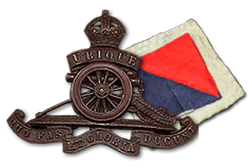54th (City of London) Heavy Anti-Aircraft Regiment, Royal Artillery
| 54th (City of London) Heavy Anti-Aircraft Regiment | |
|---|---|
 Royal Artillery cap badge and AA patch | |
| Active | 1922–1954 |
| Country | |
| Branch | |
| Role | Air Defence |
| Size | Regiment |
| Garrison/HQ | Putney |
| Engagements | The Blitz |
- 454th (City of London) Anti-Aircraft Regiment, Royal Artillery, redirects here
54th (City of London) Heavy Anti-Aircraft Regiment was a volunteer air defence unit of Britain's Territorial Army from 1922 until 1954. In World War II it defended London during The Blitz and later served in the Middle East.
Origin
German air raids by Zeppelin airships and Gotha bombers on London and other British cities during World War I had shown the need for strong anti-aircraft (AA) defences in any future war. When the Territorial Army (TA) was reformed in 1922 it included a number of dedicated AA units of the Royal Garrison Artillery (RGA). The fourth of these was 54th (London) Anti-Aircraft Brigade, RGA, (TA), comprising 160th, 161st and 162nd (London) AA Batteries, headquartered in Putney.[1][2] It was assigned to 27th (London) Air Defence Brigade.[3]
As Britain's AA defences expanded during the 1930s, higher formations became necessary. 1st AA Division was formed to cover London and the Home Counties in 1935, and the 54th AA Brigade was reassigned to 26th (London) AA Group within the division. The Royal Garrison Artillery had been absorbed into the Royal Artillery (RA) in 1924; in 1938 the RA replaced its traditional unit designation 'Brigade' by the modern 'Regiment', which allowed the 'AA Groups' to take the more usual formation title of 'Brigades'. Anti-Aircraft Command was formed in April 1939 to command all TA air defences.[1][2][4] 54th AA Regiment formed an additional battery, No 312, at Putney in 1938–39.[5]
World War II

When AA Command mobilised on 28 August 1939, a new 48th AA Bde was formed in South London, to which 54 AA Regt was assigned.[6][7]

In the summer of 1940, along with other AA units equipped with 3-inch or the newer 3.7-inch AA guns, the 54th was designated a Heavy AA Regiment.[1] It continued to serve with 48 AA Bde in 1 AA Division defending London during the Blitz[8][9][10]
In 1942 the regiment sailed to the Indian Ocean. 162 (London) Battery went to East Africa Command, where it later formed part of a composite 'F' Regiment.[11] The rest of the regiment went to Ceylon, where by September 1942, 160 and 161 (London) Batteries had been joined by 159 (Lloyds) Battery from 53 (City of London) HAA Regiment.[10][12][13] 159 Battery later moved on to 52 (London) HAA Regiment and took part in the Burma Campaign 1944–45.[13][14][15][16]
In May 1943, 54 HAA Regiment moved to Egypt, where it came under the non-operational 8th AA Bde in Middle East Forces. It remained there until it was placed in suspended animation in February 1945.[1][9][10][17][18]
Postwar
When the TA was reformed in 1947, the regiment was reconstituted as 454 HAA Regiment (City of London), RA, TA based at Lytton Grove, Putney, as part of 67 AA Bde[1][9][19]
On 1 January 1954 the regiment was merged into 452 (London) HAA based at Acton.[1][19]
Honorary Colonel
The following officer served as Honorary Colonel of the regiment:
Prominent members
On 1 September 1939 the artist Edward Ardizzone was mobilised at Putney with 54th HAA Regiment. By December he was a Bombardier with F Troop of 162 Bty. He was commissioned as a 2nd Lieutenant on 23 December, leaving the artillery and becoming an official war artist in February 1940.[24]
Notes
- ^ a b c d e f Litchfield, p. 164.
- ^ a b 1 AA Division 1936–39 at British Military History
- ^ Titles and Designations.
- ^ AA Command at British Military History
- ^ Army List, 1938–39.
- ^ 1 AA Division 1939 at British Military History
- ^ AA Command 3 September 1939 at Patriot Files
- ^ 1 AA Div at RA 39–45 Archived October 20, 2013, at the Wayback Machine
- ^ a b c 1 AA Division 1940 at British Military History
- ^ a b c 54 HAA Rgt at RA 39–45
- ^ Joslen, p. 491.
- ^ Routledge, Table XXXVIII, p. 253.
- ^ a b Joslen, p. 519.
- ^ 53 HAA Rgt at RA 39–45
- ^ 52 HAA Rgt at RA 39–45
- ^ Farndale, Far East, p. 357.
- ^ Joslen, pp. 484–5.
- ^ Routledge, Table XXV, p. 164.
- ^ a b 444–473 Regiments at British Army 1945 on
- ^ Army List 1924–39.
- ^ Burkes 1953.
- ^ Geni.com
- ^ Krotman
- ^ Edward Ardizzone website
References
- Monthly Army List.
- Burke's Peerage, Baronetage and Knightage, 100th Edn, London, 1953.
- Gen Sir Martin Farndale, History of the Royal Regiment of Artillery: The Far East Theatre 1939–1946, London: Brasseys, 2002, ISBN 185753302X.
- Lt-Col H.F. Joslen, Orders of Battle, United Kingdom and Colonial Formations and Units in the Second World War, 1939–1945, London: HM Stationery Office, 1960/Uckfield: Naval & Military Press, 2003, ISBN 1843424746.
- Norman E.H. Litchfield, The Territorial Artillery 1908–1988 (Their Lineage, Uniforms and Badges), Nottingham: Sherwood Press, 1992, ISBN 0-9508205-2-0.
- Brig N.W. Routledge, History of the Royal Regiment of Artillery: Anti-Aircraft Artillery 1914–55, London: Royal Artillery Institution/Brassey's, 1994, OCLC 852069247
- Titles and Designations of Formations and Units of the Territorial Army, London: War Office, 7 November 1927 (also in Litchfield, Appendix IV).
